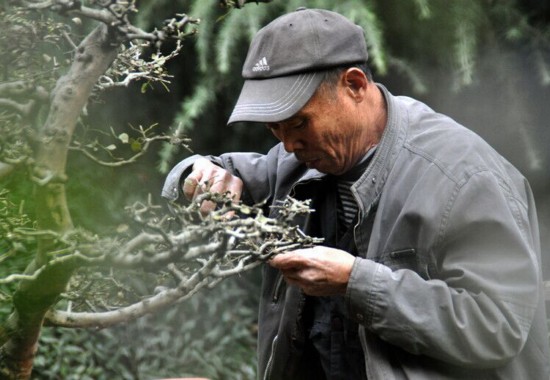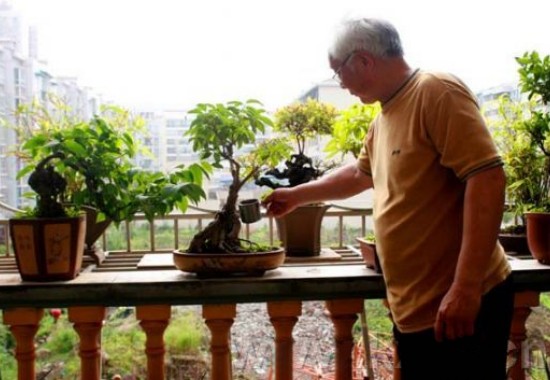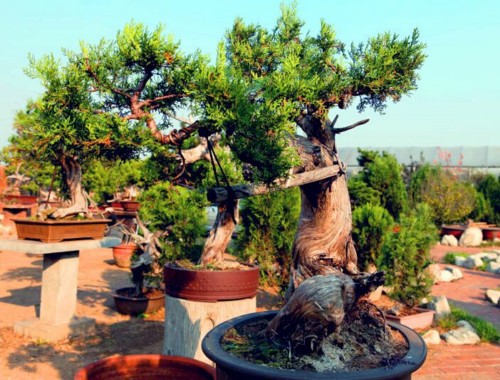Pruning technique of bonsai with tree stump
Tree stump bonsai is a kind of living work of art that plants old woody plants are planted in a basin, after years of pruning, binding, fertilization and other artistic processing, fine management, so that the trunk is vigorous and powerful, branches and leaves luxuriant. It will not be shaped because of the first artificial modeling, but continue to grow and change according to the laws of nature. therefore, the usual maintenance management is very important.

Pruning: bonsai trees are still growing. If they are allowed to grow naturally, unchecked, they will inevitably affect the shape of the trees and lose their artistic value. Therefore, it is necessary to prune in time, long-skill short cut, secret skill sparse cutting, in order to maintain beautiful tree posture and appropriate proportion. Bonsai, which has been formed, must be divided into different tree species, and measures such as coring, pruning, thinning, wiping buds and picking leaves must be taken to make it maintain a wonderful posture.
Pruning: bonsai trees often produce many new branches. in order to keep their appearance beautiful, we must always pay attention to repair skills. The way of trimming should be determined according to the shape of the tree. if it is a cloud shape, the branches should be trimmed into a flat shape. Generally hinder the beauty of dead branches, parallel branches, cross skills, etc., should be cut off in time. Especially for some pile scenes with plastic branches, new branches often emerge during the growing period. These prominent branches should be cut off in time to keep the branches flat and clear.
Root pruning: combined with root pruning when turning the basin, the root system that is too dense and too long should be pruned, which can be considered according to the following circumstances. If the new root of the tree is underdeveloped and the root system is not covered with the bottom of the soil block, the original basin can still be used and the root system does not need to be trimmed. For the tree species with developed root system, if the fibrous root is densely covered with the bottom of the soil block, the larger basin should be replaced, the dense root system should be thinned, the old root should be removed, and a few new roots should be retained to turn the basin. Some old pile bonsai can be properly raised to increase its ornamental value when turning the basin. And prune off the old root and the root tip to loosen and fertilize the soil to promote the new root.
Winter is the best pruning period for deciduous tree species, which should be carefully pruned, such as sagging weak branches, disorderly branches, cross branches, overlapping branches and so on, so as to make the crown dense, hierarchical and orderly. In short, the stump bonsai needs long-term maintenance, careful observation and patient pruning in order to cultivate a beautiful tree shape.
Time: 2019-06-12 Click:
- Prev

Fertilization skills of tree stump bonsai
The soil in the pot of tree stump bonsai is limited, so the nutrients are also limited, so we should pay attention to the supplement of fertilizer. Because of its artistic characteristics, tree stump bonsai should not be fertilized too much or too frequently. It is necessary to master the content and types of fertilization and grasp the fertilization season. The three elements of plant growth nutrients are nitrogen, phosphorus and potassium fertilizer.
- Next

The Main Points and Modeling Techniques of Platycladus orientalis Bonsai Scenery
Picking shoots and relics are important skills to master in making Platycladus orientalis potted landscape. Picking shoots is actually pinching leaves. Because the young branches of Platycladus orientalis are grown from scaly leaflets, they can be controlled by pinching the young branches and leaves. At the same time, it is also the only choice to organize the ten states, standardize the tree appearance and clean the landscape.
Related
- Fuxing push coffee new agricultural production and marketing class: lack of small-scale processing plants
- Jujube rice field leisure farm deep ploughing Yilan for five years to create a space for organic food and play
- Nongyu Farm-A trial of organic papaya for brave women with advanced technology
- Four points for attention in the prevention and control of diseases and insect pests of edible fungi
- How to add nutrient solution to Edible Fungi
- Is there any good way to control edible fungus mites?
- Open Inoculation Technology of Edible Fungi
- Is there any clever way to use fertilizer for edible fungus in winter?
- What agents are used to kill the pathogens of edible fungi in the mushroom shed?
- Rapid drying of Edible Fungi

